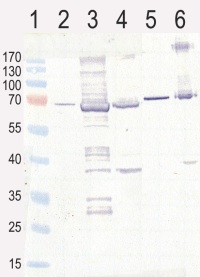The Glutathione S-Transferase (GST) family of enzymes contains cytosolic, mitochondrial, and microsomal proteins that are capable of multiple reactions with a multitude of substrates, both endogenous and xenobiotic. GST catalyzes the conjugation of reduced glutathione which is useful in the detoxification of endogenous compounds such as peroxidized lipids, as well as the metabolism of xenobiotics. GST is used to create the GST gene fusion system in which the GST moiety is used to detect and purify proteins of interest. This GST-fusion protein can then be purified from cell extracts via its high affinity for glutathione. Fusion proteins offer an important biological assay for direct protein-to-protein interactions.
Advanced Targeting Systems announces the release of a new rabbit polyclonal antibody to GST (unlabeled, Cat. #AB-45ap). It is also available labeled with HRP (Cat. # AB-45AP-HRP). Both are useful for the detection of GST fusion proteins.

